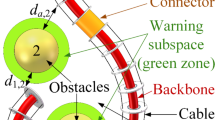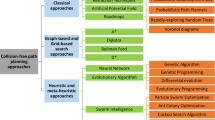Abstract
This paper introduces a new rescue robot consisting of dual-manipulator and variable configuration mobile platform for multi-purpose such as casualty extraction and hazardous goods transport. A specific rescue motion strategy using a whole-body is suggested to tackle characteristics of the robot configuration and balancing issue. In order to take into account safety and stability of the robot during the rescue motions, some restrictions are reflected into redundant domain of the robot with different priority. For stable motion control in various scenarios, a singularity-robust inverse kinematics is adopted and modified to induce smoother robot movement. The robustness of the control approach is checked numerically by comparing other method and experiments for the rescue motion strategy are carried out by using a small-scaled simulator in place of the rescue robot under development.






















Similar content being viewed by others
References
Antonelli, G. (2009). Stability analysis for prioritized closed-loop inverse kinematic algorithms for redundant robotic systems. IEEE Transactions on Robotics, 25(5), 985–994.
Baerlocher, P., & Boulic, R. (1998). Task-priority fomulatons for the kinematic control of highly redundant articulated structures. In Proceedings of international conference on intelligent robotics and systems, Victoria, Canada.
Chiaverini, S. (1997). Singularity-robust task-priority redundancy resolution for real-time kinematic control of robot manipulators. IEEE Transactions on Robotics and Automation, 13(3), 398–410.
Chiaverini, S., Egeland, O., & Kanestrøm, R. (1991). Achieving user-defined accuracy with damped least-squares inverse kinematics. In Proceedings of international conference on advanced robotics, Pisa, Italy.
Kajita, S., Kanehiro, F., Kaneko, K., & Fujiwara, K. (2003). Biped walking pattern generation by using preview control of zero-moment point. In Proceedings of IEEE international conference on robotics and automation, Taipei, Taiwan.
Kanoun, O., Lamiraux, F., & Wieber, P. (2011). Kinematic control of redundant manipulators: Generalizing the task-priority framework to inequality task. IEEE Transactions on Robotics, 27, 785–792.
Kim, D., Choi, Y., Oh, Y., & You, B. (2005). Real-time generation of humanoid motion with the motion-embedded COG Jacobian. In Proceedings of international conference on control, automation and systems, Kintex, Korea.
Kim, I., & Oh, J. (2013). Inverse kinematic control of humanoids under joint constraints. International Journal of Advanced Robotic Systems, 10(74), 1–12.
Kreutz-Delgado, K. (1990). Kinematic analysis of 7 DOF anthropomorphic arms. In Proceedings of IEEE international conference on robotics and automation, Cincinnati, Ohio.
Maciejewski, A. A., & Klein, C. A. (1988). Numerical filtering for the operation of robotic manipulators through kinematically singular configurations. Journal of Robotic Systems, 5(6), 527–552.
Mitsi, S., Bouzakis, K.-D., & Mansour, G. (1995). Optimization of robot links motion in inverse kinematics solution considering collision avoidance and joint limits. Mechanism and Machine Theory, 30(5), 653–663.
Nakamura, Y. (1986). Inverse kinematic solutions with singularity robustness for robot manipulator control. Journal of Dynamic Systems, Measurement, and Control, 108(3), 163–171.
Nakamura, Y., Hanafusa, H., & Yosikawa, T. (1987). Task-priority based redundancy control of robot manipulators. International of Robotics Research, 6(2), 3–15.
Sardain, P., & Bessonnet, G. (2004). Forces acting on a biped robot. Center of pressure-zero-moment point. IEEE Transaction on Systems, Man, and Cybernetics-Part A: Systems and Humans, 34(5), 630–637.
Sciavicco, L., & Siciliano, B. (1988). A solution algorithm to the inverse kinematic problem for redundant manipulators. IEEE Journal of Robotics and Automation, 4(4), 403–410.
Siciliano, B. (1990a). A closed-loop inverse kinematic scheme for on-line joint-based robot control. Robotica, 8(3), 231–243.
Siciliano, B. (1990b). Kinematic control of redundant robot manipulators: A tutorial. Journal of Intelligent and Robotic Systems, 3(3), 201–212.
Siciliano, B., Sciavicco, L., Villani, L., & Oriolo, G. (2009). Robotics: Modeling, Planning and Control. Berlin: Springer.
Siciliano, B., & Slotine, J. E. (1991). A general framework for manageing multiple tasks in highly redundant robotic systems. In Proceedings of international conference on adavanced robotics, Pisa, Italy.
Sugihara, T., & Nakamura, Y. (2002). Whoe-body cooperative balancing of humanoid robot using COG Jacobian. In Proceedings of international conference on intelligent robots and systems, Lausanne, Switzerland.
Vukobratovic, M., & Borovac, B. (2004). Zero-moment point-thirty five years of its life. International Journal of Humanoid Robotics, 1(1), 157–173.
Wang, L., & Chen, C. (1991). A combined optimization method for solving the inverse kinematics problem of mechanical manipulators. IEEE Transaction on Roborics and Automation, 7(4), 489–499.
Yoshikawa, T. (1984). Analysis and control of robot manipulators with redundancy. In Proceedings of the first international symposium on robotic research, Cambridge, MA.
Acknowledgments
This research was supported by a grant for the Project managed by the Agency for Defense Development. “Technology development for a rescue robot capable of lifting over 120 kgf”, funded by the Dual-use technology program.
Author information
Authors and Affiliations
Corresponding author
Appendix: Analysis on algorithmic singularity
Appendix: Analysis on algorithmic singularity
For easy analysis on the algorithmic singularity issue, 1st-order equation of the TP-CLIK consisting of only two tasks is handled instead of the Eq. (4) and the equation is rewritten as follows:
To compare both algorithms with regard to the algorithmic singularity, some terms associated with the singularity are available to be reexpressed based on the singular value decomposition (SVD). For the Eq. (24), let us define the decomposition of the \(\mathbf J _h\) and \(\mathbf J _l\) in the form
\(\mathbf J _h\) is assumed to be full-rank for simplification. Then, decomposition of \(\tilde{\mathbf{J }}_l\) is induced as follows: (Chiaverini 1997)
It is noted that a loss of rank of \(\tilde{\mathbf{J }}_l\) is related with \(\varvec{\varXi }\), which is caused by the kinematic singularity of subtask (\(\sigma _{l,n-r} = 0\)) or the algorithmic singularity (\(\varvec{v}_{l,i}^T \varvec{v}_j = 0,~ i \in [1,n-r],j \in [r+1,n]\)). Also, as the inner products get closer to zero, inversion of the ill-conditioned \(\tilde{\mathbf{J }}_l\) makes null space velocity excessively to maintain tracking accuracy of subtask.
On the other hand, inversion term of the Eq. (11) as the RTP-CLIK can be written as follows: (Chiaverini 1997)
While the kinematic singularity (\(\sigma _{l,i}\)) of the subtask can lead joint divergence, there is no effect by the algorithmic singularity. This is because \((\mathbf I _n - \mathbf J _h^\dag \mathbf J _h )\mathbf{J _l}^\dag \) makes the null space velocity of subtask decrease when the associated term, \(\varvec{v}_{l,i}^T \varvec{v}_j\), gets closer to zero.
Rights and permissions
About this article
Cite this article
Lee, W., Lee, Y., Park, G. et al. A whole-body rescue motion control with task-priority strategy for a rescue robot. Auton Robot 41, 243–258 (2017). https://doi.org/10.1007/s10514-016-9562-4
Received:
Accepted:
Published:
Issue Date:
DOI: https://doi.org/10.1007/s10514-016-9562-4




